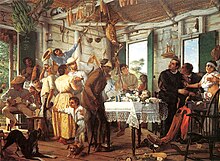
| Part of a series on |
| Puerto Ricans |
|---|
 |
| By region or country |
| Subgroups |
| Culture |
| Religion |
| History |
| Language |
|
|
| Part of a series of articles on |
| Irish Latin-Americans |
|---|
Irish immigration to Puerto Rico began during the period of Spanish colonization of the island, continuing through 19th century to the present day. During the 16th century, many Irishmen, who were known as "Wild Geese", deserted from the English Army and joined the Spanish Army. They did so either in Europe or when they could "jump ship" off the coast of Puerto Rico (whenever English ships came to trade or when the Royal Navy was engaged in attacks against the Spanish colonial forces on the island), at which time they joined the Spanish colonial army, mainly in San Juan.
Many of these men who served in the Spanish colonial army in Puerto Rico remained in the service of Spain after their military service was completed and decided to stay on the island, most often sending for extended family members from Ireland or Spain. Some married local women.
Field Marshal Alejandro O'Reilly and Colonel Thomas O'Daly,[1] among other Irish military figures, were sent to Puerto Rico from Spain during the 18th century in order to improve the capital's fortifications. This led to an increase in Irish immigration as family members were brought to the island by these Irish serving in the Spanish colonial army.
In 1797, the Spanish governor of Puerto Rico, Ramón de Castro, ordered the expulsion of the Irish from the island. This immediately led to protests from the Puerto Rican people since they had grown to respect the Irish immigrant community for their steadfast support of the island's residents. Almost all of those who temporarily fled during this time survived the witch hunt created by Governor de Castro and returned to live in Puerto Rico discreetly.
The Spanish government enacted the Royal Decree of Graces (Real Cédula de Gracias) in 1815 to encourage European Catholics of non-Spanish origin to immigrate to the last two remaining Spanish possessions in the New World, Puerto Rico and Cuba. Spain hoped to blunt the nascent independence movements in both colonies by way of this measure.
Many Irish who fled their homeland because of the Great Famine of the 1840s (over one million people died as a result of this famine) immigrated to the United States. A significant number of them went to Puerto Rico after being turned away at American ports because of epidemic outbreaks on board the ships on which they sailed. Many of these Irish settlers were instrumental in the development of the island's hugely successful sugar industry. This industry was vital to the growing local economy.
After Puerto Rico was ceded to the United States by Spain as a consequence of the Spanish–American War in 1898, many US soldiers of Irish-American ancestry were stationed in the island. They met members of the population who were island-born and Irish-descended. These soldiers stayed in Puerto Rico where they were quickly incorporated into the Irish, non-Irish, and native communities throughout the island.
The Irish influence in Puerto Rico is not limited to their contributions to the island's agricultural industry; they have also influenced the fields of education, the arts and sciences, and politics.
- ^ "Thomas O'Daly | Real Academia de la Historia". dbe.rah.es.
© MMXXIII Rich X Search. We shall prevail. All rights reserved. Rich X Search
